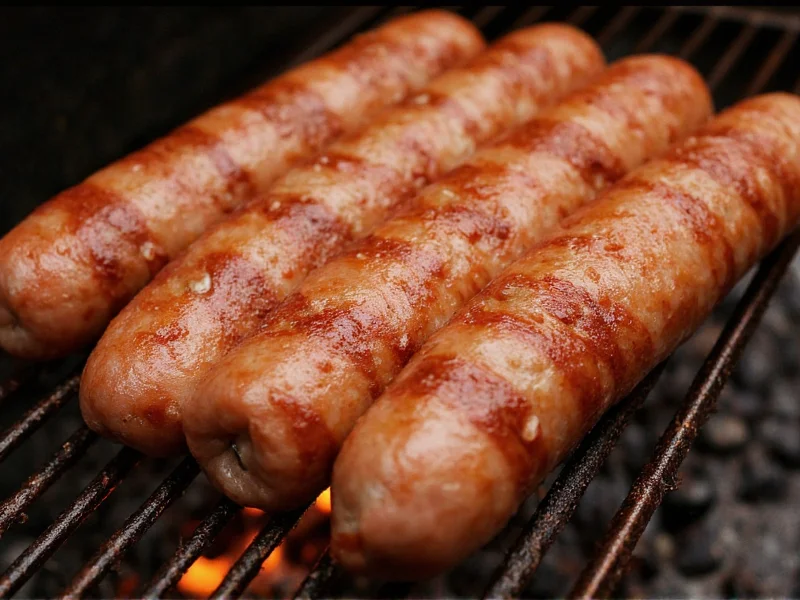The safe internal cooking temperature for pork and beef sausages is 160°F (71°C), while chicken and turkey sausages must reach 165°F (74°C) to ensure food safety. Always verify temperatures using a reliable meat thermometer inserted into the thickest part of the sausage, avoiding contact with the cooking surface.
Knowing the precise cooking temperature for sausage isn't just about perfection—it's a critical food safety requirement. Undercooked sausage can harbor dangerous pathogens like Salmonella, E. coli, and Trichinella, putting you and your family at risk of foodborne illness. The USDA Food Safety and Inspection Service has established clear temperature guidelines that eliminate these risks while preserving optimal texture and flavor.
Why Temperature Matters More Than Color
Many home cooks mistakenly rely on visual cues like color or firmness to determine if sausage is cooked. However, these methods are dangerously unreliable. Sausage can appear browned on the outside while remaining unsafe internally, or maintain a pink hue even when properly cooked due to ingredients like paprika or nitrites. Only a calibrated meat thermometer provides the accuracy needed for food safety.
| Sausage Type | Safe Internal Temperature | USDA Verification Time |
|---|---|---|
| Pork sausages (fresh) | 160°F (71°C) | Hold for 15 seconds |
| Chicken/turkey sausages | 165°F (74°C) | Hold for 15 seconds |
| Beef sausages | 160°F (71°C) | Hold for 15 seconds |
| Pre-cooked sausages (reheating) | 140°F (60°C) | Immediately |
Proper Thermometer Technique for Accurate Readings
Using a meat thermometer correctly is as important as having one. For the most accurate cooking temp for sausage measurement:
- Insert the probe into the thickest part of the sausage, avoiding contact with the cooking surface or bone
- Wait 15 seconds for digital thermometers to stabilize (instant-read models)
- Test multiple sausages in a batch, as temperatures can vary
- Sanitize the probe between readings to prevent cross-contamination
- Check temperature toward the end of cooking time, not at the beginning
Recommended thermometer types include digital instant-read models for precision and dial oven-safe thermometers for continuous monitoring during baking or grilling. The best thermometer for checking sausage temperature provides readings in 3-5 seconds with ±0.5°F accuracy.
Cooking Methods and Temperature Considerations
Different cooking techniques require slight adjustments to achieve the proper sausage internal temperature:
Grilling sausage temperature guide
Maintain medium heat (350-375°F) to prevent exterior charring before the interior reaches safe temperatures. Turn frequently and check temperature 5 minutes before expected completion. The grill's direct heat can create temperature gradients, making thermometer verification essential.
Pan-frying sausage temperature control
Cook over medium heat, turning regularly. Reduce heat if exterior browns too quickly. For thicker sausages, consider par-cooking in simmering water for 5-7 minutes before searing to ensure even cooking to the proper internal temperature without burning.
Baking sausage oven temperature
Preheat oven to 375°F. Place sausages on a rack over a baking sheet for even air circulation. Check temperature 10 minutes before the expected finish time. Baking provides the most consistent heat distribution, making it easier to reach the USDA recommended sausage cooking temperature throughout.
Avoiding Common Temperature Mistakes
Several pitfalls can compromise your cooking temp for sausage accuracy:
- Testing too early: Checking temperature before the sausage has had time to heat through gives false low readings
- Insufficient resting time: Remove sausages from heat when they're 5°F below target temperature, as residual heat will continue cooking them during the 3-5 minute rest period
- Single-point testing: Check multiple spots in thicker sausages as heat distribution isn't always uniform
- Cold thermometer: A refrigerator-cold thermometer inserted into hot sausage can give inaccurate readings—keep it at room temperature
Storage and Reheating Safety
Properly cooked sausage should be refrigerated within 2 hours (1 hour if ambient temperature exceeds 90°F). When reheating pre-cooked sausage, ensure it reaches 140°F (60°C) internally. Never partially cook sausage and refrigerate it for later completion—this creates ideal conditions for bacterial growth.
Special Considerations for Different Sausage Types
While the USDA guidelines provide universal temperature standards, certain sausage varieties require special attention:
- Smoked sausages: Though often pre-cooked, they still require heating to 140°F for safety unless labeled “ready to eat”
- Breakfast sausages: Their smaller diameter reaches safe temperatures faster—check 2-3 minutes earlier than standard links
- Cased vs. bulk sausage: Bulk sausage cooks more evenly but requires careful stirring to ensure all portions reach proper temperature
- Homemade sausage: Without commercial preservatives, requires strict adherence to temperature guidelines
Food Safety Beyond Temperature
While achieving the correct cooking temp for sausage is paramount, comprehensive food safety includes:
- Separating raw and cooked sausages to prevent cross-contamination
- Cleaning surfaces and utensils that contact raw sausage with hot, soapy water
- Washing hands thoroughly after handling raw meat
- Using separate cutting boards for meat and produce
- Storing raw sausage on the bottom shelf of the refrigerator











 浙公网安备
33010002000092号
浙公网安备
33010002000092号 浙B2-20120091-4
浙B2-20120091-4